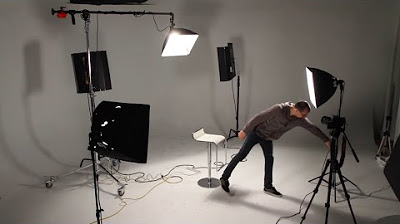Dasar Dasar Videografi
Summary
TLDRThis video provides an insightful introduction to the fundamentals of videography, focusing on key technical aspects like lighting, focus, stability, and duration to create high-quality content. It explains various camera angles such as normal, high, low, and bird’s eye views, along with shot types ranging from extreme close-ups to establishing shots. Additionally, it covers important camera movements like panning, tilting, and zooming. The video emphasizes that, beyond technical precision, compelling storytelling and engaging content are essential for a video to be both visually appealing and captivating.
Takeaways
- 😀 Proper lighting is essential for a quality video. It ensures that the subject is clearly visible and adds to the overall production quality.
- 😀 A good video must have focused or sharp visuals to make it aesthetically pleasing and clear to the viewer.
- 😀 Videos should have a sufficient duration to allow viewers to appreciate the content fully, without being too short or rushed.
- 😀 Technical aspects are important, but the story and content of the video play a critical role in making it enjoyable and engaging.
- 😀 The angle of the camera determines the perception of the subject and can significantly influence the message or emotion conveyed in the video.
- 😀 There are five basic shot angles: normal angle, high angle, low angle, top angle, and bottom angle, each serving a different purpose in storytelling.
- 😀 Subjective and objective camera angles offer distinct perspectives: subjective mimics the character’s point of view, while objective captures the scene as an observer would see it.
- 😀 Extreme close-ups can emphasize a character's emotions or details, while wide shots show the environment and context in which the action occurs.
- 😀 Camera movements like panning, tilting, and zooming allow for dynamic storytelling and can direct the viewer's attention effectively.
- 😀 Framing techniques, such as medium shots, long shots, and close-ups, help to communicate the subject's importance and the overall atmosphere of the scene.
Q & A
What are the four essential requirements for a video to be considered 'worthy' or good?
-The four requirements for a video to be considered 'worthy' are: 1) Adequate lighting, 2) Clear and focused imagery, 3) Stable and smooth footage, and 4) Sufficient video duration.
Why is content considered more important than technical aspects in video production?
-Content is more important than technical aspects because a video’s narrative and engagement are the primary factors in making it enjoyable. While technical elements are crucial, without compelling content, a video may fail to captivate the audience.
How does 'Angle' or 'Perspective' in videography compare to photography?
-The concept of angle or perspective in videography is quite similar to photography. Both require careful consideration of the viewpoint or position from which the image is captured to convey the right message or emotion.
What is a 'Normal Angle' in videography, and how is it used?
-A 'Normal Angle' refers to a camera angle where the shot is at eye level, aligning with the subject’s or viewer's eye level. It provides a neutral perspective, commonly used for straightforward shots.
What effect does a 'High Angle' shot have on the viewer?
-A 'High Angle' shot, where the camera is positioned higher than the subject and angled downward, typically makes the subject appear smaller, weaker, or less significant, which can convey vulnerability or inferiority.
What is a 'Low Angle' shot, and when is it used?
-A 'Low Angle' shot is when the camera is positioned lower than the subject and pointed upward. It is often used to make the subject appear powerful, imposing, or dominant.
What is the purpose of a 'Top Angle' or 'Eagle's View' in videography?
-A 'Top Angle' or 'Eagle's View' is used to provide a bird’s-eye view of the subject. This angle can create a sense of surveillance or detachment, often used in dramatic or action scenes to give the audience a comprehensive view of the environment.
What is the difference between 'Subjective Camera Angle' and 'Objective Camera Angle'?
-A 'Subjective Camera Angle' takes the viewer's perspective from the viewpoint of a character, without showing the character, making it feel like the audience is seeing through the character's eyes. An 'Objective Camera Angle' is more neutral, showing the subject from an external viewpoint, without aligning it to any character’s perspective.
What is an 'Extreme Close-Up' shot, and why is it used?
-An 'Extreme Close-Up' shot focuses on a specific detail, such as a part of a character's face or an object. It is used to emphasize emotions or minute details, providing insight into the character's thoughts or reactions.
How does a 'Long Shot' differ from an 'Extreme Long Shot'?
-A 'Long Shot' captures a subject from a distance, emphasizing the subject's location or environment, whereas an 'Extreme Long Shot' is taken from an even greater distance, making the subject appear much smaller within the frame, often to highlight their surroundings.
Outlines

Esta sección está disponible solo para usuarios con suscripción. Por favor, mejora tu plan para acceder a esta parte.
Mejorar ahoraMindmap

Esta sección está disponible solo para usuarios con suscripción. Por favor, mejora tu plan para acceder a esta parte.
Mejorar ahoraKeywords

Esta sección está disponible solo para usuarios con suscripción. Por favor, mejora tu plan para acceder a esta parte.
Mejorar ahoraHighlights

Esta sección está disponible solo para usuarios con suscripción. Por favor, mejora tu plan para acceder a esta parte.
Mejorar ahoraTranscripts

Esta sección está disponible solo para usuarios con suscripción. Por favor, mejora tu plan para acceder a esta parte.
Mejorar ahoraVer Más Videos Relacionados

Flash photography for beginners part 1

How to make ANY video CINEMATIC | tips, tricks & definition

あのジンバルメーカーから本格的なライトシリーズが登場!!!【ZHIYUN MOLUS B100,200,300,500】

Filmmaking 101 - Three Point Lighting Tutorial

Tutorial animasi 3D blender 2.8 bahasa indonesia Pt 5 - Lighting dan Animasi

Video Instruksional || Teknik Videography Dalam Pembuatan Iklan Layanan Masyarakat
5.0 / 5 (0 votes)
